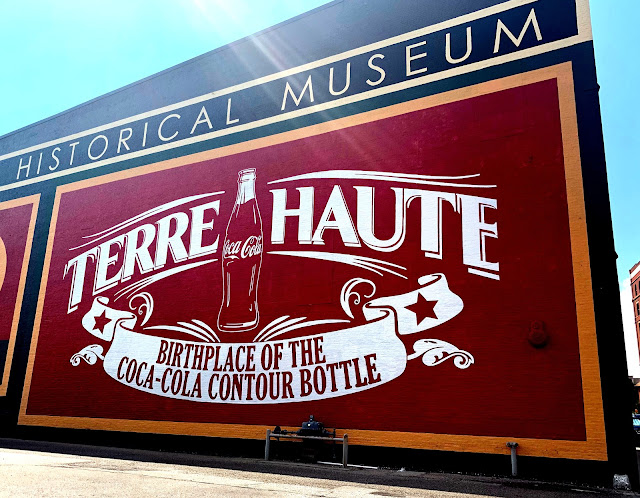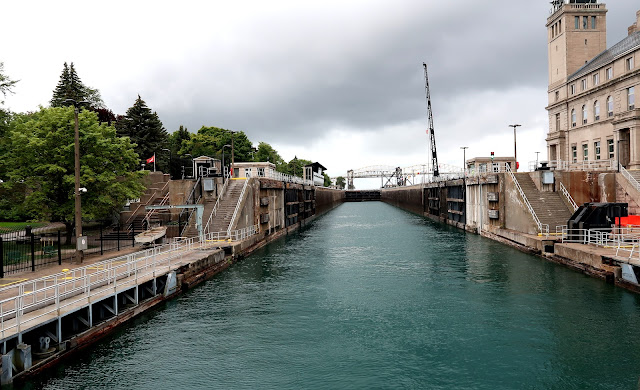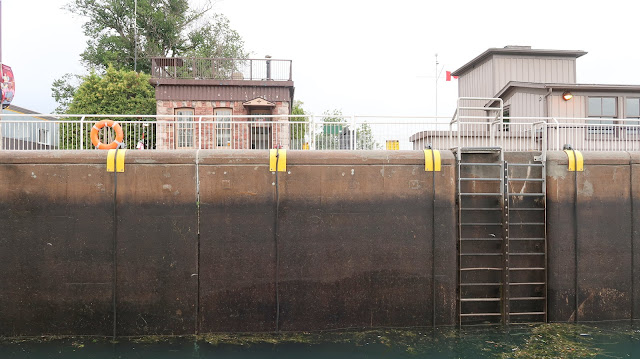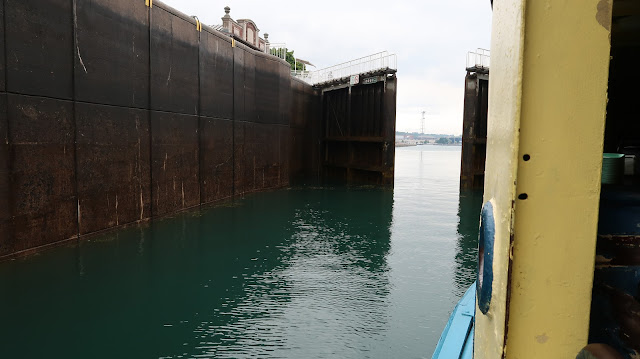It was almost unbelievable. You will recall in the last post that we blew a tire approaching Franklin, Kentucky, and we had a problem with one of the new BigFoot levelers, prompting our return to Michigan.
Then, finished in Michigan, and while cruising along I-65 upon our return trip back to the same RV park in Franklin and--this is the unbelievable part--not far from where the blowout previously occurred, two bright warning lights suddenly appeared on Phannie's annunciator panel (sorry, that's the aeronautical term; I don't know what else to call it). One of the lights proclaimed that the parking brake was set while Phannie's transmission was in gear; the other called attention to the fact that the other light was on. Along with the lights came a constant intermittent buzzing sound that provided yet an additional warning that the parking brake was set when it shouldn't be. Well, I appreciated all the warnings, but the only way I could have missed any of them was to have suddenly expired at the steering wheel. There is no way to miss these warnings if you're alive.
Ominously, the rearview TV monitor and the dash air conditioning went dead at the same moment the annunciator lights illuminated and the buzzer sounded. This can't be good, I thought. I didn't know until a bit later just how not good it was.
At that moment, I reverted to the training from my airline flying days when presented with a whole slew of problems: Fly the airplane first, analyze the situation and then work on the fix according to procedure. Since Phannie was driving in a perfectly normal manner, I kept going straight down the highway and analyzed the problem. I knew that if the air brakes had suddenly deployed as indicated, there would be mayhem in the coach, as everything not tied down in the back would suddenly be in the cockpit. Then, as a test, I applied the brakes gently, which appeared to slow the bus normally; when I released the brakes, Phannie returned to normal speed smoothly with no resistance. So, from that, I knew there was nothing wrong with the brakes. I thought about the non-functioning rearview camera monitor and the dash air, and I figured this had something to do with the ignition switch, as the ignition key must be on for these things to get electrical power to operate. The same is true of all four of Phannie's slides. As soon as we reached our RV park in Franklin, I immediately tried to operate the slides which, as I suspected, didn't move. Having completed this bit of troubleshooting, I was pretty sure the problem was with a fuse, relay or solenoid associated with the ignition switch. I had spare fuses, but none of the other parts. I also didn't know where to look for any of these things on the coach. There are several fuse panels in various places with many fuses in them, and I didn't relish the idea of pulling each one and then perhaps not even finding that one had blown.
Facing the prospect of spending the night with all the slides in was not something very desirable, and not being any good at reading electrical diagrams, I went to the Tiffin RV Network Forum on the Internet--probably the best resource ever for a Tiffin owner. Any problem that has ever occurred on a Tiffin coach can probably be found there and discussed exhaustively. I typed in a short descriptor of the problem and, in seconds, I had the answer--just as I suspected, it was probably a bad ignition solenoid, and I even learned where I was likely to find it. It also identified the location of a 10 amp fuse that protected the solenoid. I quickly found and checked the fuse mentioned and, sure enough, it was blown. I replaced it, turned on the ignition, and it blew again instantly. This seemed to confirm that the problem was the solenoid.
Well, I was no better off, because I didn't have a replacement solenoid, and I was pretty sure no one in Franklin, Kentucky had one, either. However, Red Bay, thank God, was our next stop, and taking a Tiffin product to Red Bay is like Jesus raising Lazarus from the dead as written in the Bible. Like Lazarus, even a dead Tiffin could be brought back to life in Red Bay!
Sandy and I looked at each other and marveled at the coincidence of all the problems we've had at this location. Phannie, who has performed almost perfectly for more than 90,000 miles, seems jinxed by Franklin, Kentucky. This, unfortunately, did not leave us with good memories of this town, which is unfair, because I'm sure it's a very nice place.
My attempts to fix the problem had reached the limit of my meager capabilities, so we began to accept the reality that we would be spending the night without extending any slides, especially the bedroom ones, which were kind of important for getting ready for bed. While this was certainly do-able, as Phannie's roof air conditioners worked fine, there were a couple of problems: 1) The king-sized bed was now blocking the drawers where our underwear and other sort-of essentials are kept and 2) We would have to crawl over the bed instead of walking around it like civilized old geezers. Now this might not seem like a big deal to those of you youngsters or you oldsters who are not besieged by arthritis, knee problems, fake joints and a little excess portliness. However, for us, who have all of these maladies, I can tell you that it was not pretty. I can only thank the good Lord that no one took a video of the gyrations, flops and grunts involved. It would have been a viral sensation on YouTube, I can assure you.
Although I thought about it, I was not about to try to open the slides manually because I've never had to do that, and I could readily imagine that if I had been able to get them open somehow, I might not have gotten them closed again, which would have grounded us in this backwater place for no telling how long.
We slept fine--probably due to the exhaustion of getting into bed. The next morning, we were up early after another embarrassing episode of grunting and gyrating as we crawled back out of the bed. When we were ready, Phannie's engine fired up just fine, and we filled up with diesel and pointed her toward Red Bay and our salvation. Because we had gotten on the road fairly early (something we never do and have always thought of as a curious phenomenon that might be related to demonic possession), we were able to drive a hundred miles or so without turning on the generator and running the roof airs to keep us comfortable. Meanwhile, the warning lights were still illuminated on Phannie's annunciator panel, the rear monitor was still blank, the dash air was still inop, and the annoying buzzer continued to sound for 254 miles. If you skipped over that number, let me mention again that that infernal buzzer sounded for 254 miles. After a few hours, I think I was too close to insanity to think of checking the Tiffin forum about silencing the buzzer. During this time, Sandy stayed fully awake, keeping her eye on the locations of any firearms that we may carry aboard, in case I was thinking of using that method to silence the buzzer or, worse, silence myself.
But we did make it after all, without offing myself or Phannie. It was a while before I could say anything, however; the buzzing in my ears finally faded away, and I could hear myself speak well enough to form words.
(Note: In an abundance of caution in today's nonsensical politically-correct culture, I am using my editorial discretion to avoid identifying some of the entities and persons discussed in the next paragraph.)
I drove to a local Red Bay shop we've used for years and talked to the owner, Gus, who, seeing I was close to a breakdown, told me to sit and tell him all about it. I told him what was going on, apologizing that the problem Phannie had now was far more serious than the relatively minor things for which we had made our appointment. He said not to worry, and went to work himself on the problem. In a few minutes, a guy appeared from the parts department and handed him a new solenoid and, within 30 minutes, all was normal again. I told Gus I could hug him, after which he turned to me with a scowl and said sternly, "We don't do that here in Alabama." I stepped back, due to my relatively low pain threshold, but then he started laughing, as I figured he would. Nevertheless, there was no hugging that day, just profuse thanks and firm handshakes.
So it was that simple. A week or two in which nothing seemed to go right ended with everything back to normal, and we were headed home. We stopped in Searcy, Arkansas, to see great friends Carolyn and Larry, who treated us like royalty and gave us a fine tour of their home and city, even taking us out to dinner. Thanks, guys, for your kindness; it was good to see you again.
Our next stop was near Longview, Texas, where I wanted to spend a few days seeing my old stomping ground where I used to work fueling airplanes at the airport and where I received much of my advanced pilot training back in the mid-1960s. This is also where I was based when I got my first real flying job back in 1968, flying night mail between Longview, Tyler and Dallas. It was also where I had a part time job flying as first officer on a Lockheed Super Constellation for a flying club. I'm afraid I didn't appreciate at the time what an iconic old airliner that was and that now there are perhaps only one or two still flyable anywhere in the world. Many pilots, including me, think it was the most beautiful airliner ever built. Here is a photo of the airplane I flew; we were on a layover in Acapulco when the photo was taken in 1968:
It is very sobering to realize that I am one of only a handful of active pilots remaining today who have actually flown a Lockheed Super Constellation. I was so young back then; I wish I had it to do over again. I would have appreciated it so much more.
So much had changed here in Longview over the last 50 years. I was young then, full of excitement about my chosen career, and the future and possibilities seemed limitless. It was here I knew great friends and legendary aviators who were skilled peers and mentors of mine. And now, they're all gone.
To my delight, the old familiar hangar where I worked and from which I flew, is still there:
But sadly, gone are the old airplanes and the sounds they made that are largely unheard today--the belching and coughing of radial engines like the Pratt and Whitney R-985s that powered the Beech 18 in which I flew the mail and the immense 18-cylinder Wright 3350s on the Constellation. No one there there at the hangar now knew any of the people I knew or the planes I flew and how important they were to me. And why should they? They weren't even born then. They are today who we were then, and all of their knowledge and energy are devoted to the present and the future. I am here, loitering as a stranger, an unknown and unrecognized relic of the past, and I am the only one who knows anything of that time and how wonderful it was, even though it seems like it all happened only yesterday. Bittersweet? A little; but the memories and rich and good, and I'm glad I stopped here to reminisce.
Here's a photo of one of the Beech 18s in which I flew the mail. I haven't seen one of these old airplanes in years:
Well, it's time to get back to the present. I hope I don't eventually become one of those old people who just live in the past. I don't think I will; we have too much of an exciting life nowadays, especially that awaiting us when we see our family and the grands in just a day or two. Can't wait!
Oh, by the way, while we were here, I bought and had installed a brand new set of Michelins for Phannie. The set on which I had the blowout was the better part of seven years old, so they clearly had aged out. I bought these new ones through the FMCA Michelin Advantage program, and that saved me a few hundred bucks.
I have to tell you that Phannie needs to get her act together; I've spent about ten grand on new jacks and tires in the last couple of months, so she owes me some smooth sailing for a while. Are you listening, girl?
As we head toward Conroe, I'm aware that I've lived through enough Septembers in Texas to know that this month is not much different from August and July, months when the state is largely uninhabitable, except for certain cold-blooded lizards and snakes--creatures that obviously must have slipped by Noah and boarded the Ark unnoticed, along with mosquitoes.
Anyway, I thought I was prepared for the heat again as Phannie's OAT (outside air temperature) gauge slowly climbed while we edged farther and farther southward. As it passed 90 degrees, I looked forlornly at the jackets that were still hanging on hooks behind us. We had needed them at times in Michigan and hadn't returned them to the closet, as if being within reach would somehow influence the sauna-like temperatures all around us now.
Our unexpected return to the BigFoot factory in Michigan, while tiring and frustrating, gave us at least an extra week of moderate temperatures, so we appreciated that part of it.
It won't be long until we can enjoy sitting outside again but, in the meantime, we will enjoy ourselves with the younguns. We probably won't even notice the heat; Houston--a suburb of Conroe--is the most air conditioned city in the world, I'm told.
Thank you, Lord, for this wonderful life;
please forgive me if I fail to appreciate it each day as I should.
We don't stop playing because we get old; we get old because we stop playing.
---George Bernard Shaw
"I get up every morning, and I just don't let the old man in." ---Clint Eastwood






































